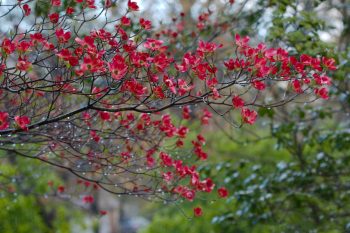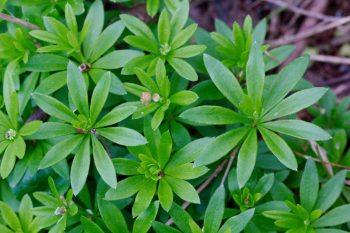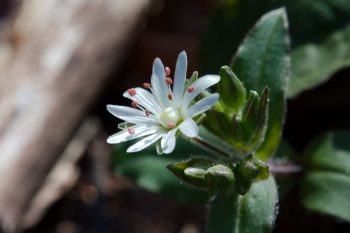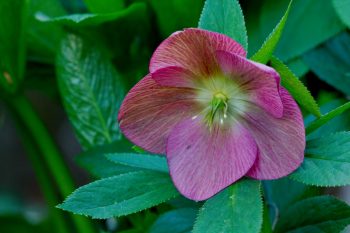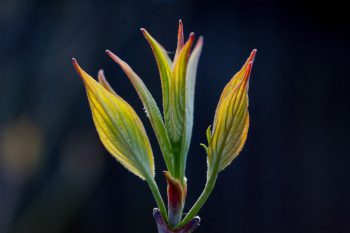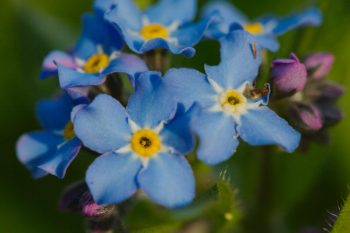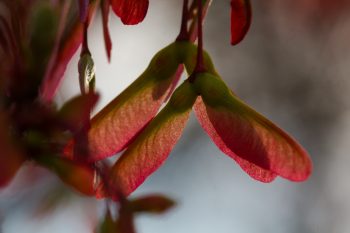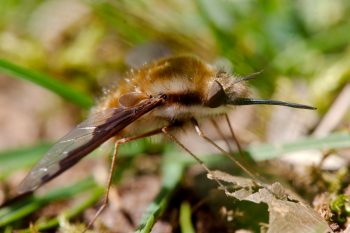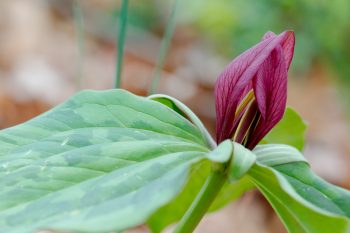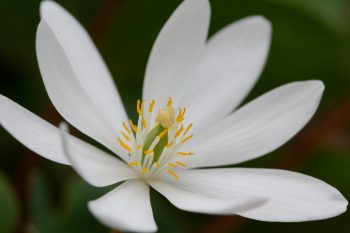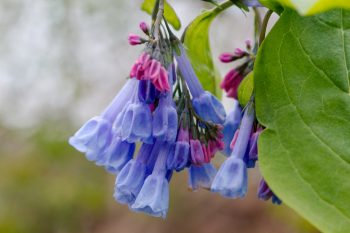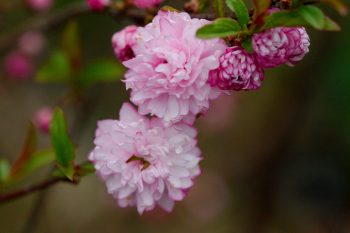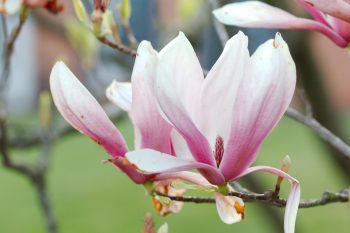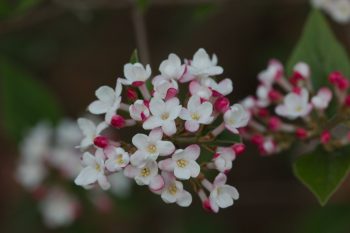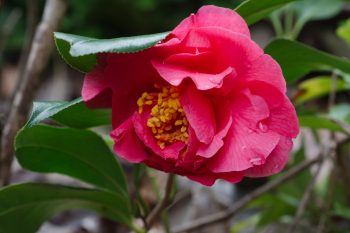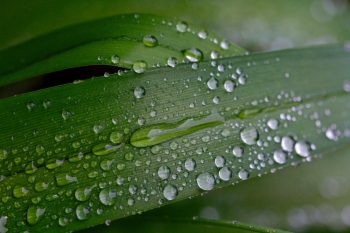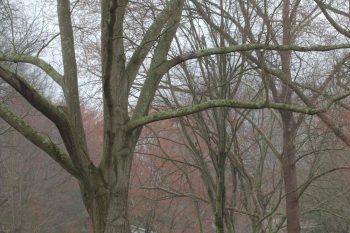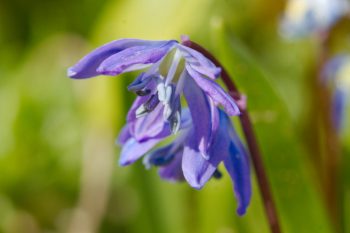We had rain overnight and it continued into the day, raining quite hard off and on. In the early afternoon I could hear thunder from my basement office and I lost the remote connection to one of my office computers, although the other stayed connected. I went out front, under the porch, and took a few pictures of the rain. In the few minutes that I was outside, the rain stopped. This photo was taken then, of a pink flowering dogwood (Cornus florida) growing and blooming at the front of our house. I loved the way the drops of water were glistening on the branches. A few minutes later I went out back and half the sky—to the south and west—was blue, while the other half—to the north and east—was still an ominous grey. The thunder faded into the distance as the storm moved on.
Pink Flowering Dogwood
Galium odoratum (Sweet Woodruff)
This will start blooming in a week or so, but even before it’s in bloom, sweet woodruff (Galium odoratum, also known as sweetscented bedstraw) is quit pretty. In fact, I’d say this photo doesn’t do it justice. The shades of green are just lovely and it makes a really nice groundcover where you don’t need something evergreen. We have a few patches of this and I really like it where it is. It isn’t too aggressive and it fits in very nicely. When crushed, it gives off a strong odor of freshly mown hay, even more so as the plant dries.
Stellaria pubera (Star Chickweed)
It was a lovely day today and Cathy and I went for a longish walk (about four miles) near Lake Frank. We saw one of the two bald eagles nesting there, who was by the nest, then flew off and around for a while before landing in another tree near the nest. We saw lots of wildflowers, including this star chickweed (Stellaria pubera), spring beauties (Claytonia virginica), and yellow trout-lily (Erythronium americanum). The ferns were coming up and we saw some jack-in-the-pulpit (Arisaema triphyllum). All in all, a very nice time in the woods.
Lenten Rose
With Easter in two days, as Lent comes to an end, the Lenten roses are finishing up a very spectacular year. They are pretty reliable, once established, but this year has been particularly good for them in our neck of the woods. This one is either ‘Red Racer’ or ‘Rose Quartz’ and I’d have to check my notes to know which. They were both planted in the fall of 2014 and are near each other but I don’t remember which is which. Regardless, it’s got a really nice color, even as the flowers age.
Dogwood Leaves
The afternoon sun was lighting up the newly opened leaf buds on a small flowering dogwood (Cornus florida) in our back yard. I got my camera and went to take pictures but between the wind moving the stems around and the sun going behind clouds, it kept changing. I think this is my favorite of them, although the light is a bit less strong than it was in others. Our eyes are amazing in terms of their dynamic range and cameras have a much harder time with extremes of light at dark. So, in the one that’s brighter, parts are a bit washed out, although in Real Life™ it was gorgeous. This one, where the light was a bit more subdued, has the right feel. Just imagine it super-bright.
Myosotis sylvatica (Woodland Forget-me-not)
The woodland forget-me-not (Myosotis sylvatica) is blooming in our back yard. Cathy planted these and they have spread to various places, mostly in the lawn, and they are very pretty little things. Similar to the flowers of the Virginia bluebell (Mertensia virginica) he buds are pinkish purple and the flowers change to blue as they open and mature. Also, the little white “eye ring” around the center change from white to yellow. They are delicate little flowers and although they are not a native species, they are lovely and don’t go to crazy in our yard, so I don’t mind.
Photo 175,000 — Maple Samaras
Cathy and I went for a walk in the neighborhood after work this evening. I had hoped to have a photo of a pile of rocks dressed up as a nurse. There is a house a few blocks from us with a stack of rocks, between 4½ and 5 feet tall. Occasionally they “dress” them in something for the occasion, such as with a Santa suit at Christmas. Yesterday, Cathy saw them in a nurses outfit, presumably in honor of health care workers during the covidian interval. Unfortunately, they were back to their bare selves this evening. So, instead, I give you photo number 175,000 from my camera, some maple samaaras, or winged seed capsules on a tree down the street from us.
Technically, this is only photo number 174,983 because the photos are numbered from 1 through 9,999 and then it starts over at 1, meaning there is no photo numbered 10,000, 20,000, etc., so the 175,000th photo will have been taken tomorrow (but I probably won’t post that one).
Bombylius major (Greater Bee Fly)
I went out to take pictures last this morning, taking a short break from work. I had expected to take pictures of flowers of one sort or another but I happened to see this greater bee fly (Bombylius major) and was able to get pretty close to it and got a reasonable photo. It’s a fairly distinctive looking fly, with a hairy body. Differentiating flies from bees is generally easy if you can count their wings. The order Diptera, which is the flies, is so named because they have two wings (i.e. a single pair) instead of the normal insect wing count of four (two pairs).
Trillium
The third and final photo I’ll post from our visit to the Montgomery County Agricultural History Farm Park today. This is trillium and someone more in the know than I am could probably tell you which one. I’ll guess Trillium cuneatum, “the largest and most vigorous of the sessile trilliums that are native to the eastern U. S.” but I stress, that’s just a guess without much research behind it. Whichever it is, it’s a pretty little plant that should be in any woodland garden in our region. They don’t transplant well but it seems to me they would be worth the effort.
Sanguinaria canadensis (Bloodroot)
Another photo from our trip to the Montgomery County Agricultural History Farm Park on Muncaster Road. Bloodroot (Sanguinaria canadensis) has very pretty, pure white flowers that don’t last very long. I love them as a true sign of spring. There are some places where you see this native plant in the woods one day as you drive by and then it’s gone the next. The plant is still there, obviously, but not so obvious without it’s bright blooms. The leaves are quite interesting, being deeply-scalloped. The leaves continue growing after the blooms are gone, and are present until mid to late summer when the plant goes dormant.
Mertensia virginica (Virginia Bluebells)
Like most folks, we’re mostly confined to our house and to walks in the neighborhood. We figured that we could go for a drive so yesterday we went out and about. One place we went was the Montgomery County Agricultural History Farm Park on Muncaster Road. I didn’t take my camera with me, which is pretty unusual, so we went back there today with my camera this time. There were a few others there but everyone kept their distance from one another.
They have a small, woodland garden that is particularly nice right now, with mostly early spring blooms. These Virginia bluebells (Mertensia virginica) are just starting to open and are so lovely.
Flowering Almond
This is the little flowering almond growing near the corner of our garage. It’s done pretty well the last few years, as we’ve had relatively mild winters but I don’t think it’s ever going to get more than about four feet tall. Maybe it isn’t in the best spot but it’s nice to have when it’s in bloom. There was a bumble bee on it and I tried to get pictures of that but this late in the day it’s in shadow and there just wasn’t enough light to get a sharp enough shot. The flowers are nice by themselves, though.
Magnolia × soulangeana
Most of the saucer magnolias (Magnolia × soulangeana) have finished their bloom but there are a few in the neighborhood that are still at their peak. This has been a good year for the magnolias, coming a little early and with no late frost to damage them. The saucer magnolia is a hybrid of M. denudata x M. liliiflora. The first of those, the yulan magnolia, has pure while flowers, which seems like it would be very nice, as well. The second, commonly called the lily magnolia, is a bit more hardy and provides the hybrid with its color. Many of the named varieties of saucer magnolia come from a breeding program at the U. S. National Arboretum. The hybrid epithet comes from Chevalier Etienne Soulange-Bodin (1774–1846), a “disgruntled cavalry officer.”
Viburnum carlesii
One thing Cathy and I are thankful for is walks in our neighborhood. It’s a relatively quiet neighborhood, especially now, as traffic in the area is considerably lighter than normal. Foot traffic has always been high with a lot of dog walkers and people out for a stroll but that’s increased significantly during the covidian interval. This shrub, Viburnum carlesii, is scattered through the area and right now, you can often smell it before you see it. The fragrance it strong, spicy, and sweet with a hint to me of vanilla. This and Viburnum × burkwoodii, which is cross with V. utile, are among the best viburnums for fragrance (and it’s possible that the one in this photo is the hybrid rather than the species). In fact, Cathy has requested that I plant one in our yard when we’re able to browse the garden centers once more.
Camellia
There is a pink flowering dogwood (Cornus florida) growing up against the front of our house. I’m almost certain it’s a seedling, because it’s much too close to the house to have been planted and I want to take it out. Before I do, I’d like something growing that will take its place but I may just need to do the deed. A few years ago I planted a camellia called ‘Mrs. Lyman Clarke’ but the two very cold spells we had in the next two winters did that one in. In 2017 I bought a variety called ‘Kumasaka’, which is fairly hardy, as camellias go. It nearly died the first year but there is a small stem with about 8 leaves on it and this spring it bloomed. I’m not entirely sure this is ‘Kumasaka’ and not the root stock, but it’s a big, beautiful, pink flower so I’ll live with it. Hopefully it will live with us. And hopefully it will start to put on a little growth because right now, it’s barely taller than the pachysandra.
Water Droplets
We had another rainy day today, to end March. It’s been so warm and sunny lately that it was a bit of a shock to stay indoors all day. I did get outside long enough to take a handful of pictures, but really not much more than that. These are daylily (Hemerocallis) leaves with rain on them, and the rain continued to fall while I was taking it. I probably should have spent the time to get a tripod and really focus carefully, but I just needed to get a picture. Maybe next time. Sorry.
Daffodil ‘Actaea’
This is a daffodil called ‘Actaea’, which is in the poeticus division (division 9), which are distinguished by their large white petals and small, dainty cups in contrasting colors. I think they are fairly posh, compared to their more boisterous cousins but they are similar in their hardiness. They are a bit slower to produce large clumps, though, so if you want a lot of them in a hurry, you’ll want to plant more of them up front. The stems on these are a little less rigid than the others, as well, and they have a tendency to droop even more when it rains but in the sun, they are hard to beat.
Social Distancing
After our BoxCast church service, Cathy and I went to a local park early Sunday afternoon. There were about a dozen cars there, spaced out in the large parking area. We walked around what, for 45 years, was Redgate Golf Course. Last summer it was shut down and at least for now, it’s a park, left pretty much as it was when it went dormant. The grass is fairly long and the weeds are pretty thick on tees and greens but it’s still recognizable as a golf course. We saw an American Kestrel (Falco sparverius) over the driving range and heard a rumor that there is a great horned owl nesting somewhere on the propoerty.
Rainy Day
After a week of mostly beautiful weather, today was grey and rainy. It was nice to be home from the office, meaning I didn’t go into the basement much, but mostly I just read and dozed and did this and that all day. I did go out in the evening to take a few pictures but there wasn’t much to see and I didn’t feel like walking around in the wet to find something more interesting. This is the view to the southeast from the front of our house, looking past a few large oaks to more trees at the end of the block. The maples are mostly in bloom, which accounts for the rusty red shades. The oaks will be out soon, adding a bit of yellow and then everything will be dusted heavily with pollen.
Scilla siberica
Blooming shortly after the beautiful, blue Chionodoxa forbesii (glory of the snow), the Scilla siberica (Siberian squill) are starting to come out. They are a darker blue with down-turned flowers but quite similar. In fact, “some experts have merged Chionodoxa into the genus Scilla under the belief that the differences are not significant enough to warrant separate genus status.” (Missouri Botanical Garden, Plant Finder). I don’t really care one way or the other and just enjoy them both as spring ephemerals. I look forward to their bloom every year and don’t think I could have too many of either.

